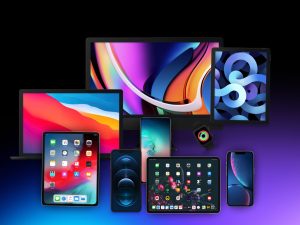Typography is a crucial aspect of UI (User Interface) design as it makes the content of a digital product legible and readable. A well-designed and adequately selected typography system can significantly improve the user experience and create a unique visual identity for digital products. In this article, we will discuss why limiting the number of typefaces used to two, using type size and weight to depict an information hierarchy and the importance of font pairing in UI design.
You need only two typefaces
First, it’s important to understand why limiting the number of typefaces used to two is an essential principle of typography in UI design. The main reason for this is to simplify the design process and ensure consistency throughout the product. Using one typeface for headings and titles and another typeface for body copy helps to distinguish different levels of importance in the content and creates a clear hierarchy. This makes it easier for users to understand the structure of the content quickly and improves their overall experience.
The type size, and weight are also important elements that can be used to depict an information hierarchy. Larger type sizes are usually used for headings, while smaller ones are used for body copy. Bold typefaces can be used to emphasize important text elements, while regular weights are used for long-form content. This helps to guide the user’s eye and makes it easier to find the information they are looking for.
Font pairing
Font pairing is another essential aspect of typography in UI design. The right combination of typefaces can greatly enhance the overall look and feel of the product. It’s important to choose typefaces that complement each other and have a similar x-height. This ensures that the content remains legible at different sizes and creates a harmonious and cohesive design.
When it comes to achieving the best font pairing, it’s essential to consider the brand’s visual identity and the purpose of the digital product. For example, a more traditional and severe brand may benefit from using a serif typeface for headings and a sans-serif typeface for body copy. In contrast, a more playful and modern brand may benefit from using a bold sans-serif typeface for both headings and body copy.

It’s also important to consider the context in which the digital product will be used. For example, a digital product that is designed for use in low-light conditions may benefit from using a sans-serif typeface with a larger x-height, as this makes the content easier to read. Similarly, a digital product that will be used on small screens, such as a mobile phone, may benefit from using a sans-serif typeface as this is more legible at small sizes.
The brand’s personality
Another important factor to consider when choosing typefaces is the brand’s personality. The typeface used should reflect the brand’s values, personality, and target audience. For example, a brand that is designed for children may benefit from using a more playful and whimsical typeface, while a brand that is designed for financial services may benefit from using a more traditional and serious typeface.
When it comes to choosing typefaces, it’s also vital to consider the legibility of the typeface. The typeface should be legible at different sizes and have good character spacing and kerning. This ensures that the content is easy to read and reduces the risk of eye strain.
Text color
In addition to choosing the right typeface, it’s also important to consider the color of the text. The color of the text should contrast nicely with the background color, making it easy to read. Dark text on a light background is generally the most legible. Still, it’s essential to consider the context in which the digital product will be used, as well as the brand’s visual identity when choosing the color of the text. For example, a digital product designed for use in low-light conditions may benefit from using light text on a dark background.
When pairing typefaces, it’s essential to consider the typeface’s style, such as its serif or sans-serif nature and its stroke thickness. This helps to ensure that the typefaces complement each other and create a harmonious design. For example, a sans-serif typeface with a bold stroke thickness can be paired with a sans-serif typeface with a lighter stroke thickness.
In addition to font pairing, it’s important to consider the spacing between lines of text, known as line height. A good line height helps to ensure that the content is legible and improves the overall readability of the digital product. It’s essential to choose a line height that is large enough to provide ample space between lines of text but not so large that it creates excessive white space.
In some situations, consider the use of special typographic elements such as quotes, pull quotes, and footnotes. These elements can be used to emphasize certain parts of the content and create a visually exciting design. However, it’s important to use these elements sparingly and ensure that they complement the overall design.
As we discussed earlier, by limiting the number of typefaces to a maximum of two typefaces, selecting the correct type size and weight to depict an information hierarchy and font pairing, designers can create a clear and legible design that enhances the overall look and feel of the digital product. When choosing typefaces, it’s important to consider the brand’s visual identity, the purpose of the digital product, and the context in which it will be used. By taking these factors into consideration, designers can achieve the best font pairing for their digital products.
Here are some useful sites that will help you to select your font pairing for your next project:




